WORK+SPACE



Personal and professional accomplishments—from running a marathon, to landing a new client or dream job, to mastering a new skill—are always the culmination of focus, determination and disciplined habits, practiced consistently over time. Where our last issue focused around coaching, this issue shares informative articles and inspirational concepts that highlight the monumental impact that small, positive habits can play on our lives.
Our intention for the articles in the coming pages is to provide you with thought-provoking yet practical ideas that can be applied to help the success of any team. Small tweaks and consistent habits took Ben Hunt-Davis' British rowing team from near-amateurs to gold medalists—be sure to read his concepts we share on page 3. James Clear highlights the importance of building good habits in his best-selling book, Atomic Habits, which has become a game changer for us personally, as well as for our company. We also share some habits and traditions we’ve built over time at Hughes Marino that have been critical to strengthening our tight-knit company culture over the years.
From a real estate perspective, we are always wanting to empower our friends and clients with valuable information you might not hear elsewhere, and this issue of Work+Space® is no different! No matter the industry and where you may find yourself in the life of your lease, be sure to read the article on page 9, and keep it on hand for the future so you understand all your options. We also explore a topic that’s rarely talked about in the legal industry, as a way to help law firms get the most desirable lease terms, which can be eye-opening for anyone handling their company’s real estate, regardless of industry. For our industrial readers, we outline the most important factors when selecting the right warehouse for your business to thrive. Lastly, as you may know, we have been on a steadfast mission to bring our conflictfree services to more and more cities across the U.S.—and are proud to announce the opening of our latest office in Houston, TX.
We hope this issue inspires—or reignites—your commitment to your goals, large and small, personal and professional, through the power of implementing consistent habits to bring you years of success.
Jason Hughes Chairman & CEO
Hughes Marino
Shay Hughes
President & COO
Hughes Marino On the Cover: The British rowing team celebrating their monumental gold medal win in the 2000 Olympics in Sydney, Australia.
Hughes Marino is a global corporate real estate firm that specializes in representing tenants and buyers—not landlords. We provide a full suite of services for occupiers of commercial real estate on an integrated and turnkey basis. Whether you need help with real estate strategy, site selection, and negotiations around renewal, expansion, relocation or subleasing, construction project management, planning and design, corporate culture, and operating expense review and/or lease administration, Hughes Marino can address any problem or opportunity for companies of any size, any industry and at any stage of their real estate life cycle—anywhere on the planet.
Corporate Headquarters 1450 Front Street San Diego, CA 92101 1.844.662.6635
hughesmarino.com

BY JASON & SHAY HUGHES
One of our favorite books, Will it Make the Boat Go Faster?, written by British Olympic gold medalist rower, Ben HuntDavis, shares the inspiring story of his team’s path from merely participating in the international circuit to reaching the utmost pinnacle of success on the world’s stage. After years of coming in last in international competitions and decades without medaling, the British rowing team became ruthlessly focused on a singular and profound goal: making their boat go faster. That one goal became the team’s driving force and litmus test of every decision they made. They relentlessly pursued that purpose and questioned everything they did in the process. They scrutinized every minute detail, looking for
ways they could make their boat go faster, and at the same time, eliminating anything that didn’t make the boat go faster. Ultimately, their myopic focus led the British rowing team to one of the greatest turnarounds in rowing history, taking them from consistent last place finishes to bringing home the gold in the 2000 Olympics in Sydney, Australia, the first time since 1912. Recently, our team was fortunate to learn firsthand from Ben on how he has distilled those learnings into a framework that anyone—and any team and company, no matter the industry—can apply to their personal and professional lives. Here are four of the most valuable takeaways we learned and are applying daily as a team at Hughes Marino.
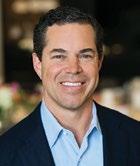
Jason Hughes founded Hughes Marino in 2011, an award-winning global real estate advisory firm that specializes in representing tenants and buyers. A pioneer in the field of tenant representation, Jason has specialized in representing tenants and buyers for more than 30 years. Contact Jason at 1-844-662-6635 or jason@hughesmarino.com to learn more.

Shay Hughes is president and COO of Hughes Marino, a global real estate advisory firm that specializes in representing tenants and buyers. Shay writes about business leadership and company culture on her blog, Lead from Within. Contact Shay at 1-844-662-6635 or shay.hughes@hughesmarino.com to learn more.
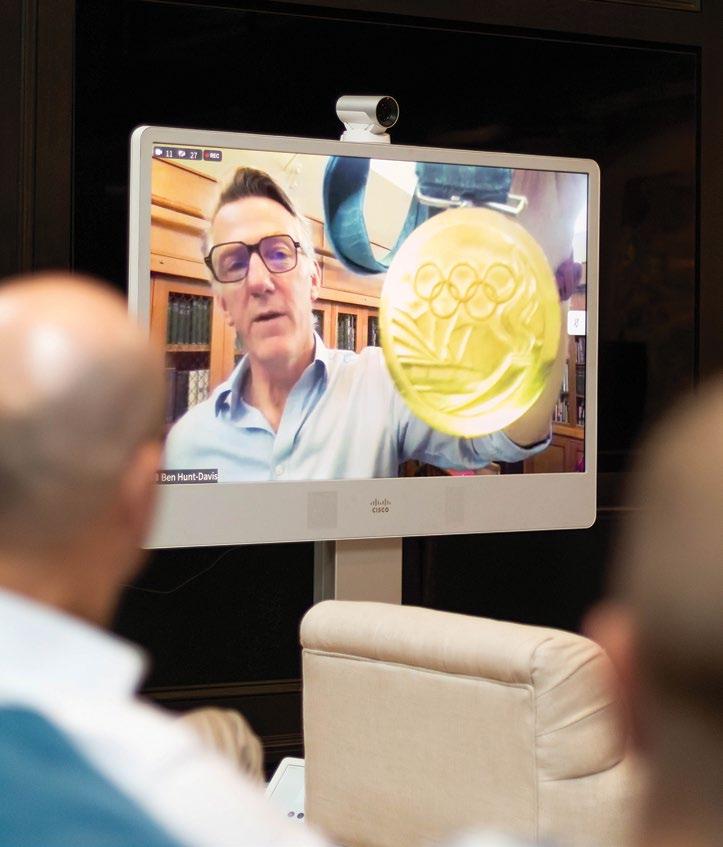
Left: Ben shows his Olympic gold medal while speaking to our team during an All-Team meeting.
Below: The British rowing team during the 2000 Olympics, which went on to win the gold. Photo provided by the Will it Make The Boat Go Faster? team.

Do you ever ask yourself or your team, what is a goal that is so demanding and ambitious that people will think you are nuts for trying to achieve it? That’s what Ben calls the “Crazy Goal.”
In the case of the British rowing team, the path they would take to become an Olympic eligible team would look vastly different than the path they needed to take to be a gold medal winning Olympic team. The team’s ultimate crazy goal was not to just be in the Olympics, but to win the Olympic gold. Ben made the great point that how big you set your goals determines how good you are going to become.
Getting really clear on that ambitious goal provided Ben’s rowing team with a critically important and clear lens through which everything else was then evaluated. Case in point, running was a usual part of rowing team training programs. But the UK team determined that running wasn’t the highest use of their physical output and in fact, didn’t make the boat go faster. Therefore, they removed running from their training plan to focus all of their energy on things that truly made the boat go faster.
With your own team, plan time to sit down and determine what your team’s crazy goals are. What are you truly wanting to achieve? Are you aiming to be a participant in the race, or to actually win the race? What is your team’s equivalent to earning a gold medal?


Ben shared a profound concept around performance versus results. While the result—winning the gold medal—is what they get measured by, how they perform should be their focus. As Ben said, they could control their performance. It’s similar to another famous coach we love at Hughes Marino, the former head coach of Alabama’s football team, Nick Saban. He is famous for saying "Trust the process and the wins will follow." It was through that singular focus on optimizing their daily performance that they identified the physical, technical, equipment and mental performance indicators that would help them achieve their crazy goal.
To create accountability for their singular goal of making the boat go faster, they measured their performance so they knew precisely where improvement was happening and where it was not. They challenged each other to get curious about every aspect of performance, even minor details that could easily be overlooked. Every detail that contributed to their performance that they could control needed to be optimized. In a race sometimes decided in less than a second, the aggregation of marginal gains can be the difference maker. In the business world, this same concept can be applied. What can we control about our performance, and what actions can we take to measure and optimize that performance?


In the case of Ben’s team, there was a lot they couldn’t control. They couldn’t control the weather conditions, the wind speed, the water’s choppiness, the other team’s practice plans, how comfortable the hotel bed at the race site might be, and on and on. Instead of focusing on the things that were out of their control, they focused on two things.
First, they identified everything they could control and optimized those factors to their maximum ability. They were relentless in controlling the controllables and doing everything in their power to improve each one of those factors for maximum performance. They knew they couldn’t control how fast other teams might row on race day, but they had control over their own performance. Whether anyone would row faster that day was out of their hands, but they knew if they crossed the finish line at their goal time, that would be fast enough to win in past races, so they set
their sights on achieving that time. They were focused on controlling the controllables.
Secondly, they identified everything they couldn’t control, but that they could influence. Of all the variables that were out of their control, they devised a plan of how best to exert influence over those variables, so the team was prepared and aligned on how to handle those variables if they arose.
If it wasn’t something they could control or influence, they let it go, as they didn’t want it to take up space in their heads. It is critical to ask ourselves: what can I actually control, and am I optimizing all the levers of those controllables? Where does my time and energy truly need to be directed to optimize the controllables? And of the things that are out of my control, how can I have influence over them? Breaking that down can help us focus where our time and energy is best spent and help disregard non-productive distractions.
Much like any team, whether an athletic team, a company or a family unit, Ben’s rowing team was comprised of many different personalities from different backgrounds. While not everyone had to be best friends, there was a deep mutual level of respect and commitment toward the common goal among the entire team. That commitment meant following the agreed-upon framework, taking responsibility for their individual contributions and uplifting each other.
But it also meant that they all had a responsibility to each other to speak up if something wasn’t working. One of the most profound statements Ben shared with our team was, “If you see something that’s not as good as it could be and choose not to discuss it, you’re helping us lose.”
They took this so seriously that they felt that they would be contributing to the team’s downfall if they remained silent on a matter that needed to be addressed.
It takes a strong commitment to your goals to both start—and stop—what isn’t working and to have the courage to speak up when something isn’t going to directly contribute to accomplishing the crazy goal.
One of the most profound moments of Ben’s talk was when he spoke about the opening ceremony of the Olympics. One might imagine the opening ceremony being one of the most memorable nights for an Olympian, celebrating the enormous milestone of making it to the Olympics—but for Ben’s team, there was no celebration. Their race was set for the next day, day one of the games, and the team collectively decided that attending the opening ceremony wasn’t going to contribute to accomplishing their crazy goal—and in fact could negatively impact their performance. Instead, they stayed home and watched the ceremony together on TV and went to bed early. Every single one of their competitors participated in the opening celebration—but Ben’s team won the gold medal.
We also loved that Ben shared an image of the nearly 60 people on their team who contributed to helping make the boat go faster. While there were just nine men that stood with Olympic gold medals around their necks that day, there was a whole team behind those nine that was just as invested in the team’s success as those in the boat racing. Every single person on the entire team contributed to the gold medal win, by optimizing performance, controlling the controllables and working together as a united team towards their crazy goal of winning gold.

IF YOU SEE SOMETHING THAT’S NOT AS GOOD AS IT COULD BE AND CHOOSE NOT TO DISCUSS IT, YOU’RE HELPING US LOSE.” “

TRY DISCUSSING THIS WITH YOUR TEAM:
• What is the crazy goal you are all working towards?
• What are the controllables you can control?
• What are the areas you can’t control but can be prepared to influence if they arise?
• How can you optimize your performance, so you get the result you want?
• What actions should you take and how do you measure them?
• Are there any obstacles in the way of accomplishing your crazy goal that you can remove?
While most of us don’t possess the physical prowess to become an Olympic athlete, we do have it within our power to accomplish crazy goals that bring great personal and professional success and fulfillment. By getting focused and aligned on you or your team’s crazy goal, learning and improving everything you can control and focusing on optimizing every facet of your performance, ultimately everyone can achieve a version of their crazy goal.
The British rowing team’s roadmap to success is a brilliant reminder of how powerful a simple concept can be. By asking the simple yet truly profound question, Will it make the boat go faster?, records can be set and crazy goals can be achieved.
How can you and your team make your boat go faster? We’d love to hear! ☐
willitmaketheboatgofaster.com

For companies seeking to better align their current and future business needs with their commercial lease—whether your lease is expiring soon or several years down the road—it’s critical to understand that you have options at every stage. From determining the optimal space to improving your negotiation position, partnering with a tenant advisor can lead to significant savings, better space utilization and more options than you thought possible.
Whether you have the right amount of space or need more (or less) space, here are just a few of many considerations to help you navigate your options based on three of the most common lease expiration scenarios.
If your lease is nearing expiration, the first step is to reassess your space requirements. Is your current space still the
right size? Hughes Marino offers a complimentary Needs
Assessment tool to help determine your optimal space needs, factoring in future growth and department adjacencies. With the shift to remote and hybrid work models, it is possible that your space needs have changed. Understanding your true space needs is essential before engaging in lease renewal discussions or exploring new locations.
Never negotiate a lease renewal without considering relocation alternatives. Exploring other submarkets can create leverage and help you achieve better economic terms, whether you decide to stay or move. It 's crucial to avoid using the landlord’s broker as a dual agent since their primary loyalty is to the landlord. Instead, work with an independent advisor who can present objective opportunities without conflicts of interest.
The cost of moving may be lower than expected, with landlords often offering substantial incentives such as free rent and moving allowances. Additionally, below-market subleases oftentimes come “plug and play,” minimizing moving costs while upgrading your environment. Whether you need more space, less space or simply want to optimize your current setup, we can guide you through the entire process.
SCENARIO TWO
With two to four years left on your lease, it’s time to rethink your space usage. The post-Covid landscape might necessitate a remodel or upgrades. Consider negotiating with your landlord for these improvements in exchange for a lease extension. While landlords may push for higher rents, it is essential to understand the market and have expert representation to avoid overpaying. Our experts can provide you with ideas to enhance functionality and save money.
If your lease is a few years in, you might be facing increasing operating expenses passed on by the landlord. These should be carefully reviewed for compliance and irregularities. Many tenants overlook this area, potentially missing significant refunds for overcharges. An audit by our team could uncover these errors and return the savings to your business.
Consider a modified
A lease extension does not just benefit the landlord; it can also reduce your rent immediately, especially if structured correctly. Understanding your landlord’s financial situation can lead to a win-win scenario where you save on rent, and your landlord improves their property’s value. Hughes Marino can help negotiate these terms, potentially saving you more than anticipated.
When you have several years left on your lease but need to reduce rent, remodel or replace furniture, you have time to get creative. This scenario requires a deep understanding of your landlord’s financial situation and strategic planning. Approaching the landlord without this knowledge could result in missed opportunities. Hughes Marino can help craft a strategy that results in a win-win outcome, allowing for rent reduction or space improvements without significant out-of-pocket expenses.
If you need less space, early termination or subleasing might be viable options. While early terminations are not common,
they can be negotiated, especially if your landlord’s financial situation allows for it. Subleasing, on the other hand, is more common but comes with its own set of challenges, such as ensuring the subtenant’s reliability. Our experts can guide you through the process, ensuring it aligns with your longterm goals.
If your business is growing, you have significant leverage as an expanding tenant. Landlords view expanding tenants as valuable, and you can use this to your advantage. However, landlords may also attempt to charge a premium, so it's crucial to have expert advice to level the playing field. Hughes Marino can help evaluate all options, ensuring you get the best possible terms while avoiding common pitfalls.
No matter where you are in your lease cycle, understanding and leveraging your options can make a significant difference in your business’s financial health and operational efficiency. Whether you are considering renewing, relocating, downsizing or expanding, Hughes Marino offers the expertise and tools to guide you through the process, ensuring that your space aligns with your business goals and financial objectives. ☐

a copy of this





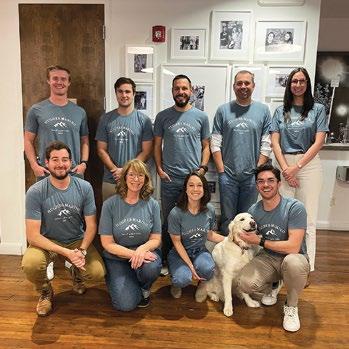


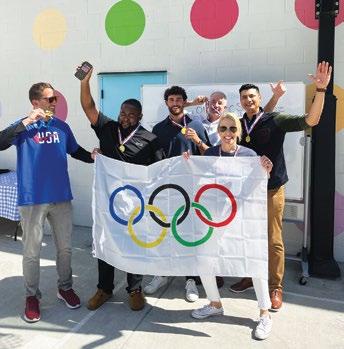






BY SHAY HUGHES
Whether you need to reignite your culture, or restart from scratch, what does it take to help your team enjoy a vibrant in-person culture again?
o one will dispute that a lot has changed about the way we work over the last few years. It’s been a bit of a rollercoaster, with people initially loving the freedom to work from home, then not loving it so much as the novelty wore off due to isolation and missing the inperson connection and collaboration that only an in-office setting could provide. Yet, people still were not really wanting to return to the office either, because for many organizations, the office—and the culture that once made it fun to be in person—has lost its luster over the last few years.

Shay Hughes President & COO Hughes Marino
As a company that prides itself on greatly valuing its team and the culture our team experiences on a daily basis, we are frequently asked how things have changed with our culture, how we’ve
dealt with those changes and what recommendations we can give to others that are having a hard time inspiring their team to want to be back in the office environment. While we are humbled and proud to have been voted the #1 best workplace in the nation by Fortune magazine, we certainly don’t have all the answers, but we are always happy to share what’s working for us.
As a whole, I’d say the best way to transform a culture— or resuscitate it if you feel like it’s on its last leg—is by the aggregation of marginal gains. Not everyone loves this answer, because most people looking for a culture fix understandably want the easiest, fastest way to make things better, but like James Clear’s approach in his genius book, Atomic Habits , that we discuss in the next article, “there is power in small wins and slow gains.” Here are a few ideas that, like the marginal gains theory, pay huge rewards over time.
While not the end-all be-all, breaking bread together is a great place to start!
I always tell people that you can’t restore culture by hosting “Taco Tuesdays” or “Pizza Fridays”—and it’s true. Simply scheduling meals isn’t going to move the needle, but it’s not a bad to place to start either. Food truly is a great way to bring people together to enjoy something other than a meeting agenda, and finding reasons to bring the team together for meals, celebrations or snacks really does help make the office day more fun. We do a lot of this at Hughes Marino, from hosting monthly birthday celebrations in every office, to serving breakfast or lunch whenever we have All-Team meetings. We also have an annual chili cook off, crockpot contests, taco truck visits, ice cream sundae parties and our annual holiday lunch tradition of homemade grilled cheese and tomato soup (yum!). We even took the advice of an article in The Wall Street Journal and tried our own “Fika,” as described as a “twice-a-day ritual in which colleagues put away phones, laptops and any shoptalk to commune over coffee, pastries or other snacks.”
Everyone on our team appreciates knowing the why behind the decisions we make, and they appreciate knowing that a lot of thought and care for the team goes into every decision we make. That builds trust, and trust is foundational to having a strong culture. If you can build that trust through being transparent and thoughtful with your own team, I can guarantee you will notice a difference in the dedication and transparency you receive from them as well.
We regularly share inspirational stories of success from all walks of life at our team meetings and in team emails, and we often bring in coaches that talk about how to have a

successful LIFE (not just be better at their job). Of course, our team does get better as we grow as individuals, but the investment in helping people have a positive outlook on their whole life and being supportive when they have challenges, is another reason they appreciate being part of a culture that truly cares about them as a person. This is consistent with who we are foundationally, as one of our core values is to “Nurture your personal and professional life.”
There are so many seemingly small rituals that developed organically over time that have now become really important traditions that bond our team on a much deeper level. Valuing these small but important cultural activities is a critical part of success by marginal gains. While we have company-wide traditions, we also empower each local team to cultivate their own unique culture, by carrying on local traditions to build a tighter bond. Traditions like Wednesday walks, Thursday stretch breaks and bring-your-own-lunch picnics outside have added a lot of fun and comradery to our days in the office. Plus, by empowering others to enhance our culture in their own unique ways, it brings many more positive layers to our team dynamic, with more teammates who feel they have an active stake in maintaining it.
Another easy-to-implement activity that is an instant and fun conversation starter? Weekly whiteboard questions! Who knew how many people would name the same favorite snacks, musicians and teams they were rooting for in the Super Bowl, World Series and NBA Finals? It’s so easy to participate, as it’s hard to resist not grabbing a pen to add your one-word answer!
The kitchen is often said to be the heart of the home, so why can’t the same be said at the office? One of our leaders recently said “bar none, the best thing for our culture has

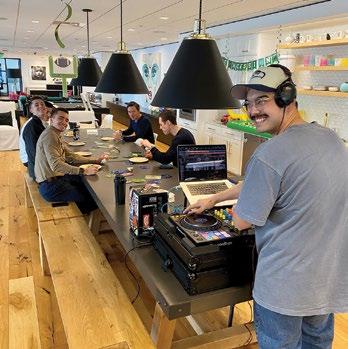
been our office’s farm table. We eat there together every day, we laugh, we share stories, we tease each other about who lost the latest pool table match up, we talk about what’s going on in the world or in our local market, we share our wins and challenges—all sitting around that table.” While not every office has the space for an extra-long farm table, having a central table for everyone to join together (as opposed to many small tables) naturally fosters conversation and builds relationships that wouldn’t happen if everyone was retreating to their cars or eating at their desks on their lunch breaks.
As another way to build comradery, during certain months of the year we set a complex puzzle on the kitchen counter. It’s a fun way to bring teammates who don’t normally cross each other’s paths during the workday to gather around a puzzle, celebrating together the placement of a few pieces every time they pass through the kitchen.
Not only does volunteering help organizations and their recipients, but giving back to others has been proven to positively impact the participants who give their time and talent. It’s also a great team bonding activity—a win-win for everyone all around! At Hughes Marino, we made a conscious effort to implement our eighth core value, “Generously give to others,” and provide three paid days off for volunteer work per year. Over the years, our teams across the country have volunteered at food banks, senior community centers and children’s museums, and have also organized toy drives, as well as park and beach cleanups, along with many other great causes.
The easy ideas are endless, but the point is that it’s the big things and the little things that matter. The big things—like treating our teammates as the incredible human beings that they are, communicating in a genuine, thoughtful and personal way, and always striving to make them proud—are irreplaceable when it comes to having a culture of deep trust and respect. But the small things are critically important too. They bring the lightheartedness to work that we can’t get at home sitting by ourselves. Over time, those small things build real relationships with people we enjoy and have so much in common with, from our core values to where we work, to what’s important to us as individuals, family members and members of our community.
Together, the big and small things add up to a solid foundation that we believe brings strength and connection to our own team. That team dynamic is a big reason why people stay with an organization. It’s also why people want to join an organization, and when they do join, a well-developed culture helps integrate new team members so that they can quickly participate and assimilate to the organization’s way of collaborating together. Foundationally, it is incredibly powerful.
While there isn’t a quick fix or a silver bullet, and it can’t be done overnight, there is no better time than now to start compounding small wins and marginal gains that over time will build a team that is united, strong and cares deeply about their teammates. At the end of the day, investing in the right culture is the surest way to cultivate a team of people that care about one another and the organization they are building together.
Investing in the right culture is the surest way to cultivate a team of people that care about one another and the organization they are building together.




BY JASON HUGHES
As a business leader, I am constantly on the hunt for inspirational reads, as well as ways to improve efficiency and spark innovation. A few years ago, I came across a book that I knew would be both a professional and personal game changer, with concepts that I have added to my daily routines to set myself—and our company—up for success.

Hughes Chairman & CEO
James Clear’s Atomic Habits has emerged as a cornerstone for anyone aiming to improve their life through small, consistent changes. The book’s core message is clear: success is not about grand gestures or once-in-a-lifetime transformations, but the result of tiny, daily habits that compound over time—the aggregation of marginal gains. This book has been named the #1 business book by The New York Times for multiple years, and since first reading this when it came out in 2018, I’ve introduced this book to our entire team, as well as our clients and friends. Since then, I have heard a countless amount of incredible feedback and have witnessed powerful results. While we highly encourage everyone to read this book cover to cover, here are some of the many impactful insights from Atomic Habits that we actively discuss at Hughes Marino, that can also help you transform your life and business.

Clear argues that habits function like compound interest in finance. Just as money grows over time through compound interest, habits accumulate and lead to significant changes when practiced consistently. Each small improvement or decline you make compounds over time, meaning the effects of your habits can either work for or against you. This principle illustrates the immense power of small, consistent actions in shaping your future. From creating daily workout routines, to carefully choosing what you eat every day, to setting smaller habitual goals at work—like hitting a certain amount of calls, writing articles or making sales—these consistent habits build a muscle that can set you up for major success over time.

One of the book’s key takeaways is that real success stems from daily habits rather than sporadic bursts of effort. Major transformations, though often celebrated, can be unsustainable. On the other hand, small, consistent habits create a solid foundation that supports long-term growth and success. It is the daily choices that ultimately define your outcomes, not the occasional grand gesture. It’s easy to get instant gratification when everyone sees and celebrates the final outcome of a project at work, or a personal goal you share with friends on Instagram. But true success is marked by the behind-the-scenes work through daily habits, discipline and dedication that bring you to that rewarding end result. Not everyone has the perseverance to stick with small daily habits, but the ones that do are building sustainable habits that improve their lives for the long term.
Your current reality reflects your past habits. Whether it is your financial situation, your health or your knowledge, these outcomes are lagging measures of the habits you have practiced over time. For example, your net worth reflects your financial habits, and your weight often reflects your eating habits. This concept reinforces the idea that you get what you consistently do. If you want to change your outcomes, you need to change your habits first. Plus, by zeroing in on final outcomes you want to achieve, you can more easily strip away the pointless tasks that fill your day that aren’t helping you reach your reward—like scrolling on your phone or rewatching a show in your downtime, when you could be working towards your goal or perfecting your craft.
Clear describes the early and middle stages of any quest as a "Valley of Disappointment." During this period, progress feels slow, and it is easy to become frustrated. However, this is a normal part of any compounding process. The most powerful outcomes are often delayed, and patience is required to see them through. Understanding that the journey may include periods of slow progress helps to maintain motivation and persistence. Have you not yet reached your goal, despite working toward it on a daily basis? The difference between great success and failure is pushing through the disappointment to get to your goal. Don’t give up, maybe you aren’t through the valley quite yet!
Goals alone are not enough. While goals provide direction, systems—the processes and habits that support those goals—are what determine success and satisfaction. Without the right systems in place, the most ambitious goals are unlikely to be achieved. By focusing on building strong systems, you create a reliable pathway to reaching your goals. Further, goals can restrict your happiness because it’s easy to put off satisfaction until we’ve hit our milestone. Conversely, when you fall in love with the process rather than the results, you don’t have to wait to give yourself permission to be happy. Rather than thinking, “I’ll be happy when I lose 20 pounds,” think, “I love that I’ve got a routine in place to work towards daily improvement.”
Boredom is one of the greatest obstacles to selfimprovement. Clear argues that the only way to become excellent is to embrace repetition and routine that come with building habits. Consider the mastery of Katie Ledecky, the greatest long distance Olympic swimmer ever. Her epic success requires doing the same thing repeatedly—over countless hours and miles in the pool—for decades. By finding fascination in repetition and embracing the boredom of routine, you can achieve excellence in any area of life. It is the consistent, repetitive actions that lead to mastery.
With all these valuable insights, it’s no wonder this has been added to the Hughes Marino reading list! Atomic Habits provides a comprehensive framework for understanding how small, consistent changes can lead to significant transformations. Whether you are striving for better health, greater success or a new skill, these principles can guide you on your journey to lasting change.

What systems would you create to see yourself succeed?

Law firms are the most sought-after tenants, yet often face the least favorable lease terms.
This may seem highly counterintuitive, at first. Per commercial real estate data analytics company, CoStar, law firms are the most attractive and desirable building tenants.
They are some of the most loyal, predictable, reliable and high-quality tenants. Historically they sign long leases and spend heavily to improve the landlord’s building. Their professionals work in the office more than other industries, bringing life, activity, status and restaurant and retail spending
that landlords desire. This in turn attracts other first-rate tenants.
One would expect these qualities to result in the best possible lease deals for law firms. Instead, the landlords have gained the upper hand and commanded premium, above-market rents.
CoStar states that of the top five classes of firms—financial services, law firms, consulting firms, tech firms and media companies—law firms pay the second highest average rent but have the longest average lease terms. On average, law firms are signing 8-year leases, though generally top-tier firms are signing 10- or even 15-year leases.

WHY THE MOST DESIRABLE
So, why aren’t law firms leveraging their strengths to secure better lease terms?
Given their quality, predictability and investment in their office space, many law firms mistakenly believe they are securing favorable terms, when in fact, the opposite is true.
Landlords have gained leverage at the law firms' expense in large part because they have controlled the narrative in negotiations.
Because law firms invest heavily in customized, highend space, landlords know that it’s expensive to move, and that nine out of 10 times, the tenant will not consider moving. In fact, the average law firm is in their space for 20+ years. Additionally, unlike tech firms, there are few law firm sublease options available.
Landlords come to the negotiating table confident that law firms are reluctant to move.


Law firms have more negotiating power than they typically use to their advantage.
First, relocating would impose significant costs to the landlord. Due to the highly customized nature of law firm spaces, a vacancy would necessitate a costly and extensive renovation for the landlord. They would have to demolish the space back to shell condition to attract a future tenant at their burden, cost and time without a premium renter.
Were the narrative to shift from “it would be prohibitive for the tenant to move,” to “landlords would face significant financial repercussions if they did,” the law firm would gain tremendous leverage.
Secondly, ahead of their lease expiration, law firms would benefit by building into their strategy how they would reimagine their space and how to communicate that vision and intention to the landlord and the marketplace.
Law firms can frame their current space as outdated and misaligned with their evolving vision. They could rightly claim that they would need to entirely gut and redesign the space, in multiple phases, with untenable pain, disruption and cost. In truth, for many law firms, it would be far more costly to stay in their current building than to craft the space needed elsewhere. In these terms, it puts the landlord on their heels and entirely changes the negotiation dynamics.
Law firms can also “consider” purchasing a building, which throws off landlords and their leasing agents from arbitraging different leasing options—and it creates opacity with purchase timing and renovations, creating leverage with early renewals and relocations.
Further, amidst the uncertainty and increasing vacancies of the post-pandemic real estate market, law firms can gain maximum leverage by partnering with a tenant focused real estate advisor who understands their unique needs and specializes in negotiating a lease or purchase on their behalf.
Though there is no universal strategy, law firms—and indeed, all companies, regardless of industry—should adopt a proactive, strategic and long-term approach to evaluating their office needs.
• What do you want your office space to say about your company?
• What would you change about your current space to fit the vision of your firm?
• How do workforce trends and new ways of working impact your future requirements?
• What is the impact on the next generation of professionals to join your firm during the tenure of the next lease?
• What is the ideal building type?
• What amenities fit your vision?
• How do location and transportation impact your employees’ retention and recruitment?
• How will the geographical area change in the next 10 years?
• How much uncertainty is there in predicting future needs?
With a thorough office needs assessment, firms can align their strategy to their priorities relative to stability, flexibility, improvements and cost while enhancing their negotiating leverage.
Whether leasing or buying a new space for their law practice, working with a tenant representation company— not a full-service commercial real estate firm that primarily represents landlords—will minimize the possibility that they will wind up severely shortchanged in terms of broker advocacy. Now, more than ever, companies need a true advocate and fiduciary looking out for their needs, maximizing their flexibility and achieving the best economics possible.
At Hughes Marino, we champion transparency and tenants’ rights. We help firms navigate recurring real estate challenges, highlighting the value of working with an advisor who represents tenants’ best interests.
We started our tenant representation roots 30 years ago by primarily representing law firms. Since then, we have grown to represent thousands of companies across all industries— locally, nationally and globally. Our level of detail, care and discretion is second to none. We recognize how important our clients’ real estate transactions are for their future success, and as such, we place their sole interests at the forefront.
No matter the size or location, our team understands the specific technicalities that come with the many facets unique to today’s law firms. Our Law Firm Practice Group has the local market knowledge and experience to ensure our clients secure the highest caliber and most cost-effective office space to fit their needs. ☐
Curious to hear more on the topic of law firm leases?
Listen to Episode 38 of The Corporate Real Estate Insider Podcast for more in-depth insights from our team , specifically about how we have been helping law firms with their leases for decades!


with New Office Led by Houston's Top Tenant Focused Commercial Real Estate Expert, Charles G. Fertitta Jr.


Houston’s commercial real estate landscape is poised for a significant transformation with the arrival of Hughes Marino, the nation’s premier firm specializing in corporate tenant and buyer representation. The company’s expansion into Houston marks its 12th location across the United States, further solidifying its commitment to serving the nation’s most dynamic and entrepreneurial business communities.
With a game changing, conflict-free focus on tenant advisory and advocacy, Hughes Marino continues to achieve remarkable growth in an otherwise stagnant commercial real estate environment.
Leading this new venture is Charles G. Fertitta Jr., a titan in Houston’s thriving, dynamic commercial real estate industry.
Charles G. Fertitta Jr. joins Hughes Marino from Colliers Houston, where he served as vice chair and principal. Charles’ remarkable track record includes recognition as Houston’s top producer in 2023, demonstrating his unparalleled expertise and commitment to excellence.
“We are thrilled to welcome Charles to the Hughes Marino team,” said Shay Hughes, president and COO of Hughes Marino. “His extensive experience, stellar reputation and passion for offering creative solutions to deliver the most optimal real estate representation for his clients make him the ideal leader for our new Houston office. Under his guidance, Hughes Marino will continue to deliver exceptional service and conflict-free results to our clients at each stage of their corporate real estate needs.”
With over 30 years of experience in the office and industrial sectors, Fertitta has not only built a sterling

“With
our award-winning culture, team mentality and singular focus on representing corporate tenant end-users of commercial real estate, rather than landlords, it all translates into significantly better service and results for our clients.
Charles G. Fertitta Jr. Executive Managing Director
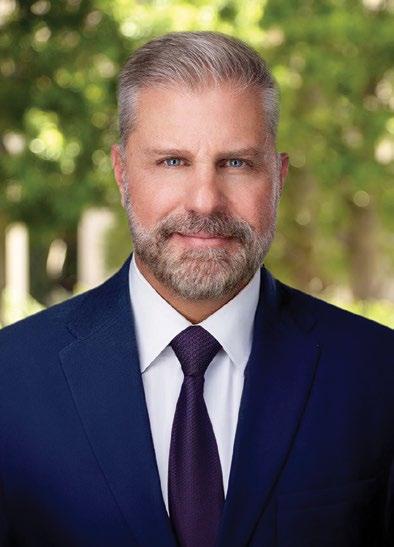

reputation but has also consistently been recognized as a top producer, most recently earning a spot as one of the Houston Business Journal's 2024 Heavy Hitters.
His portfolio includes representing some of Houston’s most prominent office users, ranging from prestigious law firms and financial services firms to cutting-edge tech companies and life science organizations. Fertitta’s influence extends even further into Texas’ industrial landscape, where he has played a pivotal role in securing real estate solutions for some of the state’s largest logistics companies. His involvement with esteemed institutions like the Texas Heart Institute further underscores his commitment to the community and his clients.
Houston’s status as a global energy capital, coupled with its burgeoning sectors in healthcare, technology and life science, makes it an ideal environment for Hughes Marino’s tailored services. Fertitta’s leadership in the new Houston office brings a level of dedication and advocacy that is unparalleled in the market. His deep roots in Houston and extensive national and global networks give him a unique perspective on the needs of businesses, ensuring that Hughes Marino’s clients receive the most effective and personalized service.
Hughes Marino’s expansion into Houston represents more than just growth—it brings a fresh, client-centered approach that directly benefits businesses in the region. By focusing on tenant representation, Hughes Marino eliminates the conflicts of interest that often arise when firms serve both landlords and tenants. This focus allows the team to deliver truly unbiased advice, empowering clients to make the most informed and advantageous real estate decisions. Central to this approach is the company's unwavering commitment to doing the right thing for its clients, a mission that permeates every aspect of its operations. Fertitta’s alignment with this mission makes him the ideal leader to guide Hughes Marino’s Houston team as they work to elevate the real estate experience for tenants and buyers, helping them secure the best possible outcomes in every transaction.
As Hughes Marino continues its strategic expansion across North America, the Houston office is set to become a cornerstone of its mission to revolutionize tenant representation.
Under Fertitta’s guidance, the Houston team will not only uphold the company’s tradition of conflict-free service but also contribute to the city’s economic vitality.
Businesses stand to benefit from Hughes Marino’s unwavering commitment to tenant advocacy—empowering them to make smarter real estate decisions with a broader range of enhanced lease and space options and greater negotiating leverage—ultimately driving their success in a competitive market.
With Fertitta at the helm, Hughes Marino’s Houston office is poised to make a significant impact on this major commercial real estate market, offering a new standard of service that is both innovative and aligned with the city’s entrepreneurial spirit.
“Hughes Marino is changing what has been a stagnant, archaic and landlord-centric commercial real estate industry,” Charles said. “I’ve been a corporate real estate advisor for nearly three decades, and there is no other company that provides the level of technology, operational support, marketing, vertical integration and specialized area expertise than Hughes Marino. Combined with our award-winning culture, team mentality and singular focus on representing corporate tenant end-users of commercial real estate, rather than landlords, it all translates into significantly better service and results for our clients.”

By Mike Paleo & Alex Foley
Selecting the perfect warehouse location is a multifaceted endeavor that goes far beyond typical space considerations. Whether you're embarking on a lease agreement or making a long-term investment in a property, warehouse site selection is a critical component of your company's competitive advantage. A comprehensive supply chain model encompasses all possible flows and facilities. Additionally, it presents various network configuration options, highlighting those with the lowest costs, enabling you to select the most suitable one for your business needs.
At Hughes Marino, we have identified five critical factors to consider when performing a site selection analysis to identify the right industrial warehouse for your business. Proximity to suppliers and customers, consideration of access to transportation networks, the region's availability of a skilled workforce, and real estate costs and availability must all be considered.



Choosing a location that is strategically positioned near your suppliers and customers can yield significant benefits in terms of reducing transportation costs, improving delivery times and fostering stronger relationships with key stakeholders.
A warehouse’s location impacts a business’ success across a number of measures—and one of the key considerations is the proximity to a business’ customer base and suppliers. In the era of instant gratification, which has driven the need for next-day delivery, customers expect fast turnaround on orders, and meeting those expectations requires strategic planning when it comes to selecting a warehouse location. Time and transportation requirements will drive up costs as well—so decisions around location need to consider the ease with which goods can be transported in and out. If goods are typically being moved via ship, a port-adjacent warehouse may be ideal. For businesses delivering goods and fulfilling online orders to inland markets, proximity to a major parcel transit hub like the Memphis Intermodal Facility or DFW International Airport will streamline operations. Other considerations that can impact shipping times include proximity to carriers with terminals and, if that’s not possible, easy access to major highways. As part of this consideration, a business should make sure to take into account the local weather patterns and risk of natural disasters, and how those events will impact operations and their ability to deliver on-time.
A skilled and reliable workforce is critical for the smooth operation of any warehouse facility. Assessing local labor market dynamics, including availability, skills and associated labor costs can help ensure that your staffing needs are adequately met. Understanding the warehouse’s workforce needs and ensuring that it is located in a market with a high number of skilled job candidates is key to a business’ long-term success. A state-of-the-art facility is of no value if there is nobody operating within its walls. Infill locations will ensure a larger local talent pool and proximity to transportation hubs, but typically demand increased rental rates, often time for older less superior product. It’s important to note that it’s increasingly challenging for businesses to find and retain skilled warehouse employees, especially since Covid, requiring not only considerations around location but also a willingness to offer competitive wages and other perks—including flexible schedules and benefits. If locating further from an urban center is the best option to reduce lease costs, businesses must consider how they will get workers to the site—and can look into employee perks such as public transportation allowances or commute rebates
Efficient access to transportation networks, including highways, railways, airports and ports, is essential for facilitating the smooth flow of goods in and out of your warehouse. Evaluating factors such as traffic flow, transportation costs and proximity to major hubs can help optimize logistics operations. Understanding the geographical distribution of your customer base and suppliers can help optimize inventory


management and distribution strategies. Accessibility to transportation infrastructure, including roads and highways, is crucial for ensuring efficient inbound and outbound logistics. Factors such as traffic density, congestion patterns and road quality should be carefully evaluated to minimize transportation costs and delivery delays.
Real estate costs vary widely depending on factors such as location, property size, age and market demand. With high-cost, port-close markets like Los Angeles commanding higher rates, your team can consider more outskirt markets with newer and improved warehouses like the Inland Empire.
In practice, companies often have specific requirements that must be considered as constraints in the supply chain network optimization process. These constraints can include limitations on the number of facilities or annual step costs that remain fixed within certain ranges. Intentional supply chain network optimization aims to identify the best combination of factories and distribution centers to efficiently meet supply and demand while minimizing costs.
It’s also important for companies to consider the potential government incentives and tax credits available to new entrants to a market. Many states will offer hefty incentives to lure a business across state lines. These incentives can be significant and in many cases the state will not only offer tax credits, but sometimes they will even source the land and fund the construction of facilities.
Conducting thorough research and financial analysis can help identify cost-effective options that align with your budget and operational requirements. Comparing buildings and different markets from a total cost perspective helps account for the hidden costs, such as inventory and franchise taxes, as well as incentives that can offset those costs, including local tax benefits designed to attract new businesses.
Ultimately, a warehouse is a critical part of a business’ longterm strategy. If there are plans to expand and grow in the near future, it’s important that the warehouse can accommodate that growth. Businesses need to have a plan for their next phase. If expansion isn’t possible on-site, for instance, they can ensure that there’s alternative space nearby to accommodate growth, so that if moving is necessary, the business can retain its workforce and make a smooth transition.
The ability to scale your business over time is directly impacted by the availability of suitable buildings. For instance, securing a facility in a prime location can enhance proximity to both customers and suppliers, optimizing operations.
However, envisioning the future, imagine your operations doubling in five years, necessitating additional warehouse space. If your initial warehouse choice was in a highly competitive area with no available expansions, significant logistical challenges may arise, requiring a complete reevaluation of location selection. This isn't to dissuade from competitive market choices, but rather to underscore the importance of considering long-term implications in warehouse site selection.

Depending on your business' import and export requirements, proximity to transportation hubs such as airports, railway stations and ports may be advantageous. Additionally, operating within a foreign trade zone (FTZ) can provide benefits such as duty deferral, tariff relief and streamlined customs procedures.
In addition to all the important considerations noted above, it is critical for businesses to leverage a tenant representation team that specializes in the industrial sector to secure a real estate outcome with the client’s best interest in mind. The industrial market has distinct specifications unlike the other asset classes. Hughes Marino specializes in assessing all the technical prerequisites needed to locate the optimal industrial space tailored to each client’s unique needs. Our experienced team knows the questions to ask, the critical requirements and the conditions to be aware of when identifying the right space for your facility. Whether you’re leasing, renewing, expanding, contracting, consolidating, subleasing, buying a building or building a space from the ground-up, our team at Hughes Marino is committed to your success. ☐
Mike Paleo is a managing director of Hughes Marino, a global corporate real estate advisory firm that specializes in representing tenants and buyers. Contact Mike at 1-844-662-6635 or mike.paleo@hughesmarino.com to learn more.
Alex Foley is a senior vice president of Hughes Marino, a global corporate real estate advisory firm that specializes in representing tenants and buyers. Contact Alex at 1-844-662-6635 or alex.foley@hughesmarino.com to learn more.
NATIONAL AND GLOBAL REPRESENTATION
BELLEVUE • BOSTON • BOULDER • DALLAS
DENVER • HOUSTON • INLAND EMPIRE
LONG BEACH • LOS ANGELES • NEW YORK
OAKLAND /EAST BAY • ORANGE COUNTY
PALO ALTO • RALEIGH-DURHAM
SALT LAKE CITY • SAN DIEGO
SAN FRANCISCO • SEATTLE
Contact us at info@hughesmarino.com We’d love to hear from you!
We can help you with your
SERVING ALL CORPORATE USERS OF SPACE, INCLUDING BUT NOT LIMITED TO OFFICE, INDUSTRIAL & LIFE SCIENCE
LEASE RENEWAL, CONTRACTION, EXPANSION & RELOCATION REPRESENTATION
EARLY LEASE RESTRUCTURING REPRESENTATION
SUBLEASING REPRESENTATION
BUILDING PURCHASE REPRESENTATION
PROGRAM, PROJECT & CONSTRUCTION MANAGEMENT
PLANNING + DESIGN
PORTFOLIO LEASE ADMINISTRATION & ADVISORY
LEASE OPERATING EXPENSES/CAM AUDITING & RECONCILIATION
CORPORATE REAL ESTATE FINANCE
CAPITAL MARKETS
CULTURE CONSULTING
Please consider us for your friends and clients’ needs as well!